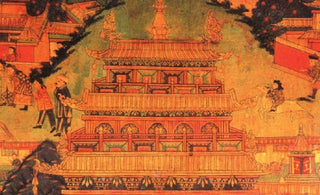
Tibetan murals stand as testaments to a rich cultural heritage that transcends time. These ancient artworks, adorning the walls of structures like the illustrious Potala Palace, encapsulate narratives of spirituality, history, and artistic brilliance. In our pursuit to understand the depths of these invaluable treasures, we uncover the profound significance behind preserving these murals and the cultural legacy they carry forward.
An Insight into Tibetan Murals
Tibetan murals, with their intricate details and vibrant colors, serve as more than mere adornments on walls—they embody a living history. Deeply embedded within the fabric of Tibetan culture, these murals stand as visual testaments to centuries-old traditions, spiritual beliefs, and historical events.
Within the walls of Tibetan monasteries and ancient structures like the revered Potala Palace, these murals chronicle a saga that traverses time. Each stroke of paint holds significance, depicting not just stories but the essence of Tibetan Buddhism, folklore, and the intricate nuances of the region's artistic heritage.
Every mural is a narrative, telling tales of compassion, enlightenment, and the journey towards spiritual awakening. These paintings often depict religious figures, mythological stories, celestial realms, and scenes from the lives of revered saints and historical events. They are not only aesthetically pleasing but also serve as educational tools, offering insights into Tibetan culture, morality, and the interconnectedness of the spiritual and earthly realms.
Potala Palace Murals: Jewel of Tibetan Art
Nestled within the resplendent walls of the Potala Palace lie treasures that transcend mere artistic mastery—they are embodiments of Tibetan culture, spirituality, and historical legacy. These murals stand as the crown jewels of Tibetan artistry, adorning the sacred halls and corridors of this UNESCO World Heritage Site.
The Potala Palace murals serve as visual archives, preserving and portraying the essence of Tibetan civilization. Each stroke of paint tells a story, depicting not just historical events but also the deeply embedded spiritual teachings of Tibetan Buddhism. These murals narrate tales of enlightenment, compassion, and the intricate philosophies that define Tibetan spirituality.
What distinguishes these murals is not just their visual brilliance but the layers of symbolism and intricacy woven into every scene. The meticulous craftsmanship, vibrant hues, and symbolic motifs unravel a tapestry of meanings. From depictions of revered religious figures to scenes symbolizing cosmic cycles, each mural offers a window into the complex interplay of spirituality, art, and culture in Tibetan society.
The Importance of Preservation
The imperative need to preserve these murals goes beyond their aesthetic appeal; it's about safeguarding a cultural legacy. The murals serve as living artifacts, bridging the gap between the past and the present, conveying the wisdom and ethos of Tibetan civilization. Preserving these murals ensures the continuity of Tibetan heritage, allowing future generations to connect with their cultural roots.
Challenges and Conservation Efforts
Preserving the intricate beauty and historical significance of Tibetan murals is a task fraught with challenges, requiring concerted conservation efforts to ensure their longevity for future generations. These challenges stem from a multitude of factors, including environmental degradation, tourism impact, and the natural aging process of these ancient artworks.
Environmental Threats and Their Impact: One of the primary challenges faced in preserving Tibetan murals is the threat posed by environmental factors. Harsh climates, fluctuating temperatures, humidity, and exposure to pollutants can lead to physical degradation, fading pigments, and the deterioration of the mural surfaces. These environmental elements gradually erode the vibrancy and structural integrity of the artworks, necessitating proactive conservation measures.
Tourism Impact: Balancing Access and Preservation: While tourism serves as a means to appreciate and understand these cultural treasures, it also poses a significant challenge to their conservation. Increased foot traffic within heritage sites such as the Potala Palace can accelerate wear and tear on the murals. Visitors inadvertently contribute to the accumulation of moisture, dust, and other contaminants, which, over time, can mar the delicate surfaces of these artworks. Balancing access for tourists while preserving the integrity of the murals remains a delicate endeavor.
Natural Aging and Deterioration: The passage of time itself presents a formidable challenge to the preservation of these ancient artworks. The organic materials used in creating the murals, such as natural pigments and binding agents, undergo inevitable chemical reactions over centuries, leading to color fading, flaking, and surface cracks. The gradual aging process demands specialized expertise and methodologies to slow down or mitigate the effects of deterioration.
Efforts aimed at conserving Tibetan murals involve a multidisciplinary approach combining art conservation, scientific research, and cultural stewardship. Conservationists employ meticulous techniques involving cleaning, stabilizing, and restoring the murals using cutting-edge technologies and traditional methodologies. Non-invasive methods like documentation, monitoring, and environmental controls play crucial roles in preserving these fragile artworks.
Restoration initiatives often involve skilled artisans and conservators who undergo rigorous training to ensure that their interventions adhere to ethical principles and internationally recognized conservation standards. These experts meticulously analyze the condition of the murals, devise tailored conservation strategies, and execute delicate procedures aimed at maintaining the authenticity and historical integrity of the artworks.
Oriental Aesthetics: Upholding Tradition
At Oriental Aesthetics, we are committed to preserving the cultural heritage encapsulated within Tibetan murals. Through our systematic and high-quality professional services, we extend support to artists, collectors, and enthusiasts who share a passion for classical oriental art. Our dedication lies in not just appreciating these masterpieces but also in ensuring their preservation for future generations.
Oriental Aesthetics stands as a beacon in the realm of preserving oriental art. Our services cater to the needs of artists, collectors, and enthusiasts, providing comprehensive support in appreciating, preserving, and promoting the cultural significance of artworks like Tibetan murals. We strive to bridge the past and the present, ensuring that the legacy of classical oriental art endures through our meticulous efforts.























